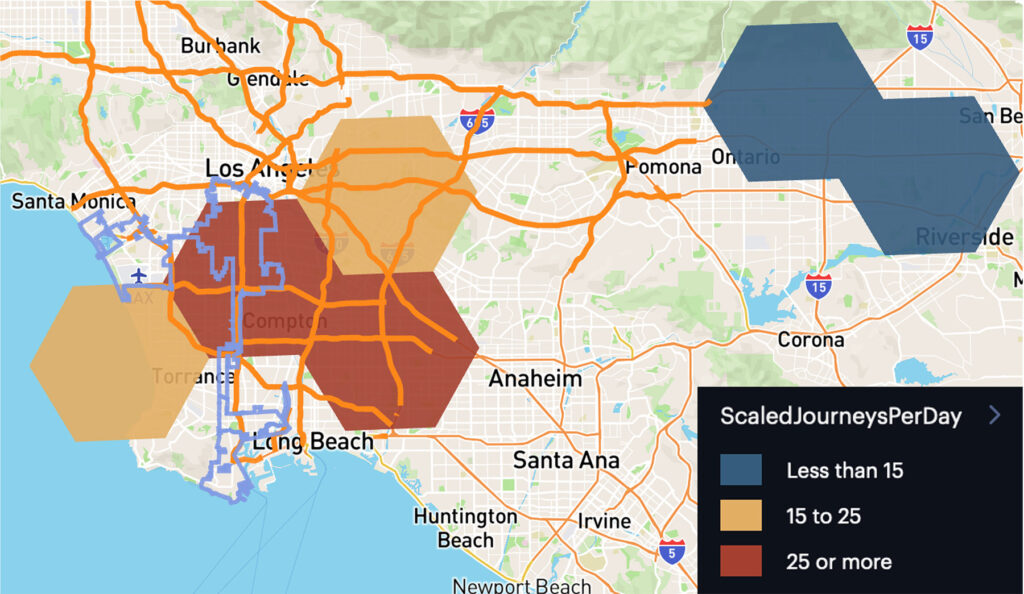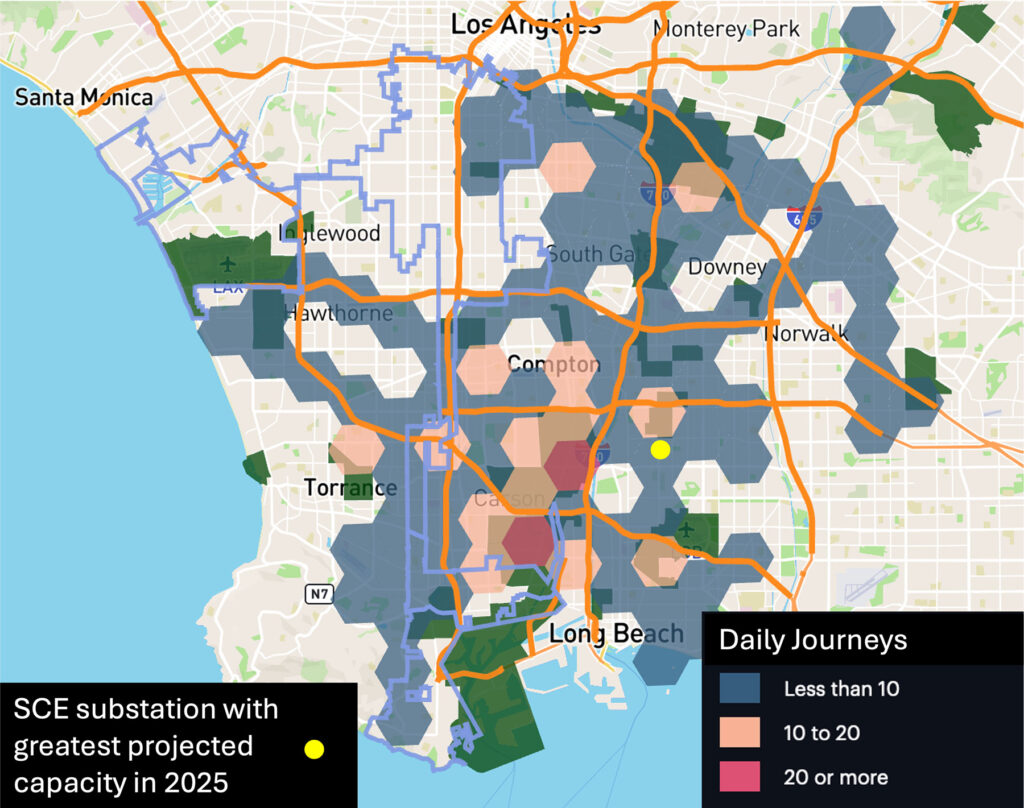
The Case for Placing Drayage Truck Chargers Away from Ports
Installing drayage truck chargers further away from ports can benefit fleets’ bottom line and operations, avoid grid bottlenecks, and reduce port congestion.
We would not have most of our everyday goods without drayage trucks. Drayage trucks are responsible for moving goods to and from ports, and today are mostly powered by diesel internal combustion engines. The estimated 60 million drayage movements in North America each year burn billions of gallons of diesel, contributing to poor air quality and poor health outcomes.
Electrifying these trucks would improve local health and reduce climate impacts. However, providing sufficient charging infrastructure in the right locations is challenging. A dearth of robust data and analysis has hampered the development of stakeholders’ electrification strategies. They need to know how many trucks are on the road, how many trips they take, and how many depots will be needed to power them should they be electrified.
That’s why RMI and the Mission Possible Partnership (MPP) analyzed drayage trucking data in Los Angeles (LA) County: to provide stakeholders with a clear understanding of where trucks typically go before and after passing through the Port of LA. The analysis also provides information about where new charging stations should be located.
Why Los Angeles?
Los Angeles County is home to the country’s two busiest ports (LA and Long Beach) and consistently ranks as one of the nation’s most polluted areas. And research shows that people living near these ports experience higher rates of asthma and are more likely to develop cancer than those living in other parts of the county.
To support the electrification of trucks and improve local health, California passed an Advanced Clean Fleets (ACF) regulation requiring that fleets buy only electric drayage trucks beginning in 2024; it also requires that all drayage trucks be zero-emissions vehicles by 2035.
Many Californian fleets, utilities, local governments, and others are worried that they won’t be able to meet these targets. A key concern is the challenges to charging deployment, a vital component of electrification. Retrofitting a site, providing charging to drivers who have their own vehicles and don’t return to a depot, and ensuring the grid can quickly and economically power electric trucks with clean energy are critical to meeting ACF requirements.
Where and How to Install Chargers
Our analysis found that creating well-located charging locations will result in faster deployment and lower grid costs, while accelerating truck, transit, school bus, and car electrification.
This information can help stakeholders direct investment toward projects that will deliver the highest impacts at the lowest costs, at the speed needed to meet ACF requirements.
Below, you’ll find the analysis’ key insights that can help you understand what fleets, policymakers, charging station developers, and others need to consider when developing and implementing their charging infrastructure strategies.
- Dispersing charging locations can alleviate congestion at ports and improve fleets’ bottom lines.
Trucks that are charging or waiting to charge take up scarce space in ports. By installing chargers further away from ports, this space can be freed up, thereby relieving congestion.
As illustrated in the map below, most drayage truck trips are within 25 miles of the port and therefore don’t need to return to a central charging depot. If stakeholders prioritize installing chargers in other areas, fleets can enjoy more operational flexibility, which will likely result in improved bottom lines. Analysis from the North American Council for Freight Efficiency (NACFE) Run on Less Electric DEPOT — a biannual event that demonstrates advances in freight efficiency across the United States — shows that today’s electric trucks can handle many existing return-to-base operations. For example, over 50 percent of drayage operations in LA travel to destinations within LA County.
Current electric truck battery ranges can easily meet fleets’ needs, which means that the transition to zero-emissions vehicles is technologically viable today, if we can use these techniques to unlock charging.

- By making chargers publicly available, fleets can help accelerate the electrification of other transportation modes while also saving money.
Charging providers want their chargers to be well-used. High-power chargers and the grid connections they require have high capital and fixed costs. A charger that can serve many types of vehicles is mutually beneficial to users; making chargers accessible to transit buses, garbage trucks, and other commercial fleets makes these fleets more likely to electrify and makes charging more economic. More vehicles help defray the costs of installing and maintaining chargers, as these other customers could take on some of the expense. Using telematics to identify where vehicles stop and start — not just where they begin and end the day — makes siting charging stations easier. Geotab’s Altitude Platform provides aggregate trucking insights on roughly 15% of the freight market in a form that lends itself to mapping and modeling. RMI has used Geotab source data since its 2022 report, Charting the Course for Early Truck Electrification.
- Today’s trucking charging stations are generally concentrated in areas with existing demand. Deploying chargers elsewhere will lessen the likelihood of grid bottlenecks while improving fleet operations.
One of the major barriers to charging deployment is getting power to existing sites: Run on Less participants waited three or more years for utilities to bring power to their sites, a problem that worsens when demand is concentrated in areas with insufficient grid capacity.
Currently, drayage truck charging stations are mostly located in ports and depots. If stakeholders continue to prioritize installing chargers in these areas, power demand will put considerable pressure on local grids, which will likely not be able to reliably support trucks’ growing charging needs, creating grid bottlenecks. These bottlenecks can have significant logistical and financial repercussions.
Stakeholders can help relieve the strain on the grid by distributing chargers over a larger area and further away from ports, in places where there is already trucking activity. RMI and MPP’s analysis shows where trucking destinations are located; this data can help them strategically prioritize where these new chargers should be installed.
For instance: the map below shows that industrial areas such as Carson and Compton have a large amount of drayage truck activity. Installing chargers in these areas would serve trucks’ charging needs while also lessening their dependence on port and depots.

Ideally, these chargers should be located in places where there is already sufficient grid capacity. Thankfully, truck routes tend to end in industrial areas, which often have a higher grid capacity than commercial and residential neighborhoods. And given that industrial zoning regulations, permitting, and approval processes are often less cumbersome than those of other locations, charging deployment projects can move along at a faster pace.
As stakeholders carry out their charging deployment strategies, they also need to consider potential effects on surrounding communities. While it’s true that nearby neighborhoods will benefit from electric trucks, which are quieter than their gas-powered counterparts and produce zero emissions, developers need to remember that new chargers can increase traffic and interfere with residents’ travel if too many trucks queue to charge. These communities need to be involved in the planning process early on to ensure that charging deployment is done in an equitable manner that meets their needs.
Improving the Economy and the Climate
To meet Advanced Clean Fleet requirements, stakeholders need to start strengthening charging infrastructure today. Moreover, drayage trucks are a critical component of port decarbonization — and ports are an indispensable physical asset critical to developing a clean industrial hub (see below). Dispersing chargers, and making them publicly available, will expedite the deployment of these chargers while also reducing the draw on the grid at the ports themselves, saving crucial grid capacity for electrification of other port equipment and onshore ship power. By expanding charger locations, trucking stakeholders can improve the economy and the climate, to the benefit of communities.
About Clean Industrial Hubs
The insights discussed above come from RMI and the Mission Possible Partnership’s Clean Industrial Hub in Los Angeles, California, that accelerates industrial and heavy transportation decarbonization in the region. Clean industrial hubs bring together policymakers, financial institutions, project developers, and community-based organizations to enable groundbreaking decarbonization projects in the hardest-to-abate sectors. In Los Angeles, RMI and MPP’s analyses, convenings, and tools support stakeholders working to advance zero-emissions trucking, low-carbon cement plants, sustainable aviation fuel, and decarbonized ports, by increasing the size, scale, and speed of critical climate investments that benefit the environment, the economy, and communities. This work is done in partnership with the Bezos Earth Fund.
Interested in learning more about truck electrification? Check out these resources:
- ACT Now: How the Advanced Clean Trucks Rule Will Impact the Electric Grid and Fleets
- Understanding California’s Advanced Clean Fleet Regulation: What Is ACF, Who Must Comply, and What Is Required for Compliance?
- Preventing Electric Truck Gridlock: Meeting the Urgent Need for a Stronger Grid
- Research from the North American Council for Freight Efficiency